|
|

This chapter describes how to install and start up your Catalyst 3500 XL switches and to interpret the power-on self-test (POST) that ensures proper operation. Read the topics, and perform the procedures in the order that they are presented:
These warnings are translated into several languages in "Translated Safety Warnings."
 |
Warning This equipment is to be installed and maintained by service personnel only as defined by AS/NZS 3260 Clause 1.2.14.3 Service Personnel. |
 |
Warning Only trained and qualified personnel should be allowed to install or replace this equipment. |
 |
Warning Read the installation instructions before you connect the system to its power source. |
 |
Warning Before working on equipment that is connected to power lines, remove jewelry (including rings, necklaces, and watches). Metal objects will heat up when connected to power and ground and can cause serious burns or weld the metal object to the terminals. |
 |
Warning Do not stack the chassis on any other equipment. If the chassis falls, it can cause severe bodily injury and equipment damage. |
 |
Warning The plug-socket combination must be accessible at all times because it serves as the main disconnecting device. |
 |
Warning To prevent the switch from overheating, do not operate it in an area that exceeds the maximum recommended ambient temperature of 113ºF (45ºC). To prevent airflow restriction, allow at least 3 inches (7.6 cm) of clearance around the ventilation openings. |
 |
Warning The device is designed to work with TN power systems. |
 |
Warning When installing the unit, the ground connection must always be made first and disconnected last. |
 |
Warning This product relies on the building's installation for short-circuit (overcurrent) protection. Ensure that a fuse or circuit breaker no larger than 120 VAC, 15A U.S. (240 VAC, 16A international) is used on the phase conductors (all current-carrying conductors). |
 |
Warning This equipment is intended to be grounded. Ensure that the host is connected to earth ground during normal use. |
 |
Warning Care must be given to connecting units to the supply circuit so that wiring is not overloaded. |
 |
Warning Unplug the power cord before you work on a system that does not have an on/off switch. |
 |
Warning Do not touch the power supply when the power cord is connected. For systems with a power switch, line voltages are present within the power supply even when the power switch is off and the power cord is connected. For systems without a power switch, line voltages are present within the power supply when the power cord is connected. |
 |
Warning Do not work on the system or connect or disconnect cables during periods of lightning activity. |
 |
Warning Ultimate disposal of this product should be handled according to all national laws and regulations. |
The following warning applies to the Catalyst 3508, 3512, 3524, and 3548 XL switches:
 |
Warning Attach only the Cisco RPS (model PWR600-AC-RPS) to the RPS receptacle. |
The following warning applies to the Catalyst 3524-PWR XL switch:
 |
Warning Attach only the Cisco RPS (model PWR300-AC-RPS) to the RPS receptacle. |
U.S. regulatory information for this product is in the front matter of this manual.

When determining where to place the switch, be sure to observe these guidelines:
 |
Note If the switch is installed in a closed or multirack assembly, the temperature around it might be greater than normal room temperature. |
 |
Note Carefully remove the contents from the shipping container, and check each item for damage. If any item is missing or damaged, contact your Cisco representative or reseller for support. Return all packing materials to the shipping container, and save it. |
The switch is shipped with the following items:
 |
Warning To prevent bodily injury when mounting or servicing this unit in a rack, you must take special precautions to ensure that the system remains stable. The following guidelines are provided to ensure your safety: |
The rack-mounting brackets supplied with the switch can be attached to a 19- or 24-inch rack. Figure 2-1 shows which mounting holes attach to the rack.
 |
Note The illustrations in this section show the Catalyst 3508G XL switch as an example. Other switches in the series (Catalyst 3512, 3524, 3524-PWR, and 3548 XL) can also be installed as shown here. |
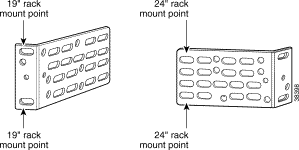
To install the switch in a 19-inch or a 24-inch standard rack, follow the instructions described in these procedures:
If you plan to install the Catalyst 3548 XL switch in a rack, you must first remove the front side screws in the switch chassis so that the mounting brackets can be attached. Figure 2-2 shows how to remove the chassis screw from one side of the switch. Follow the same procedure for the opposite side.

Figure 2-3 and Figure 2-4 show how to attach a bracket to one side of the switch. Follow the same steps to attach the second bracket to the opposite side.


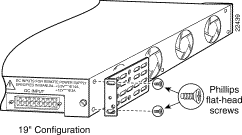

After the brackets are attached to the switch, use the four supplied number-12 Phillips machine screws to securely attach the brackets to the rack, as shown in Figure 2-5.

After the switch is mounted in the rack, attach the power cord to the switch. If you are using the Cisco RPS, see the Cisco RPS documentation for installation instructions.
After the power is connected, the System LED turns amber for 2 seconds, and then it flashes green while the switch completes the series of POST tests described in the "Powering On the Switch and Running POST" section.
We recommend attaching the cable guides to prevent the cables from obscuring the front panel of the switch and the other devices installed in the rack. If the switch is in a 19-inch or 24-inch rack, use the supplied black screw, as shown in Figure 2-6, to attach the cable guide to the left or right bracket.
 |
Note The Catalyst 3548 XL switch ships with a special cable guide as shown in Figure 2-7. This cable guide secures up to 48 cables. Use the supplied black screw to mount it on the left bracket. |


This section describes the steps required to attach the switch to a wall:
Use two of the supplied number-8 Phillips flat-head screws to attach the long side of the bracket to the switch.
Figure 2-8 shows how to attach the brackets to one side of the switch. Follow the same steps to attach the second bracket to the opposite side.

For best support of the switch and cables, make sure the switch is attached securely to a wall stud or to a firmly attached plywood mounting backboard, as shown in Figure 2-9.
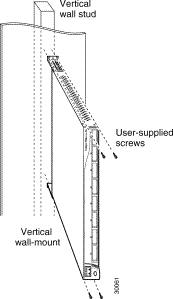
After the switch is mounted on the wall, attach the power cord to the switch. If you are using the RPS, see the Cisco RPS documentation.
After the power is connected, the system LED turns amber for 2 seconds, and then it flashes green while the switch completes a series of self-tests described in the "Powering On the Switch and Running POST" section.
Follow these steps to install the switch on a table or shelf:
Step 2 Place the switch on the table or shelf near an AC power source.
Step 3 Connect the power cord to the switch rear panel and to the power outlet. If you are using the RPS, see the RPS documentation for installation instructions.
After the power is connected, the system LED turns amber for 2 seconds, and then it flashes green while the switch completes POST.
If your configuration has an RPS, see the "Power Connectors" section and the Cisco RPS documentation.
To power on the switch after you install it, follow these steps:
Step 2 Connect one end of the AC power cord to the AC power connector on the switch.
Step 3 Connect the other end of the power cord to an AC power outlet.
As the switch powers on, it begins POST, a series of eight tests that run automatically to ensure that the switch functions properly. When the switch begins POST, the port LEDs turn amber for 2 seconds, and then they turn green. The System LED flashes green, and the RPS LED turns off. As each test runs, the port LEDs, starting with number 1, turn off. The port LEDs for ports 2 to 8 each turn off in turn as the system completes a test.
When POST completes successfully, the port LEDs return to the status mode display, indicating that the switch is operational. If a test fails, the port LED associated with the test turns amber, and the system LED turns amber. If POST fails, refer to "Troubleshooting," to determine a course of action.
POST failures are usually fatal. Call Cisco Systems immediately if your switch does not pass POST.
The switch 10/100 Ethernet ports configure themselves to operate at the speed of attached devices. If the attached ports do not support autonegotiation, you can explicitly set the speed and duplex parameters.
Connecting devices that do not autonegotiate or that have their speed and duplex parameters manually set can reduce performance or result in no linkage. To maximize performance, choose one of these methods for configuring the 10/100 Ethernet ports:
 |
Caution It takes a Catalyst 3524-PWR XL 10/100 port up to 10 seconds to initially detect, power, and link to a Cisco IP Phone. If you disconnect the Cisco IP Phone before link has been established, you must wait 10 seconds before connecting another network device (other than another Cisco IP Phone) to that switch port. Failure to do so can result in damage to that network device. |
Follow these steps to connect to 10BaseT and 100BaseTX devices:

Step 2 Connect the other end of the cable to an RJ-45 connector of the other device. The port LED comes on when both the switch and the connected device have established link.
The port LED is amber while Spanning Tree Protocol (STP) discovers the topology and searches for loops. This takes about 30 seconds, and then the port LED turns green.
If the port LED does not come on, the device at the other end might not be turned on, or there might be a cable problem or a problem with the adapter installed in the attached device. See "Troubleshooting," for solutions to cabling problems.
Step 3 Reconfigure and reboot the connected device if necessary.
Step 4 Repeat steps 1 through 3 to connect each device.
 |
Note Install the Gigabit Interface Converters (GBICs) as described in the "GBIC Module Slots" section, and then connect to the 1000BaseX ports. |
For detailed instructions on installing, removing, and cabling the GBICs (1000BaseSX module or the 1000BaseLX/LH module), refer to the GBIC documentation.
For detailed instructions on installing and cabling the GigaStack GBICs, see the Catalyst GigaStack Gigabit Interface Converter Hardware Installation Guide.
 |
Caution Do not remove the rubber plugs from the fiber-optic port or the rubber caps from the fiber-optic cable until you are ready to connect the cable. The plugs and caps protect the fiber-optic port and cable from contamination and ambient light. |
Follow these steps to connect to the 1000BaseX port:
Step 2 Insert the SC connector in the fiber-optic receptacle, as shown in Figure 2-11.
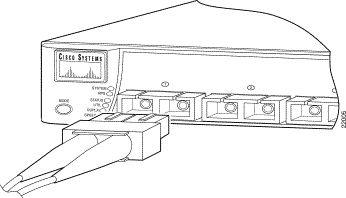
 |
Note The port status is amber while Spanning Tree Protocol discovers the topology and searches for loops. This takes about 30 seconds. The port LED then turns green. |
Connect the GigaStack cable connector to the GigaStack GBIC as shown in Figure 2-12.
For more information on the GigaStack GBIC connections and configuration scenarios, see the Catalyst GigaStack Gigabit Interface Converter Hardware Installation Guide.
Use the supplied rollover cable and DB-9 adapter to connect a PC to the switch console port. You need to provide a RJ-45-to-DB-25 female DTE adapter if you want to connect the switch console port to a terminal. You can order a kit (part number ACS-DSBUASYN=) containing that adapter from Cisco. For console port and adapter pinout information, see the "Cable and Adapter Specifications" section.
The PC or terminal must support VT100 terminal emulation. The terminal-emulation software---frequently a PC application such as Hyperterminal or Procomm Plus---makes communication between the switch and your PC or terminal possible during the setup program.
Follow these steps to connect the PC or terminal to the switch:
Step 2 Configure the baud rate and character format of the PC or terminal to match these console port default characteristics:
After you have gained access to the switch, you can change the port baud rate. See the Cisco IOS Desktop Switching Software Configuration Guide for instructions.
Step 3 Using the supplied rollover cable, insert the RJ-45 connector into the console port, as shown in Figure 2-13. See the "Identifying a Rollover Cable" section for a description of the pinout.
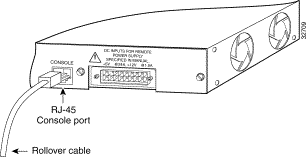
Step 4 Attach the supplied RJ-45-to-DB-9 female DTE adapter to a PC or attach an appropriate adapter to the terminal.
Step 5 Insert the other end of the supplied rollover cable in the attached adapter.
Step 6 Boot the terminal-emulation program if you are using a PC or terminal.
You can assign the switch IP address information, host and cluster names, and passwords by two methods:
This section describes each method.
You can use an automatic setup program to assign IP information and to create a default configuration for continued operation. Later, you can use the Cluster Management Suite or the command-line interface (CLI) to customize your configuration. To run the setup program, access the switch from the PC terminal that you connected to the console port. (See the "Connecting a PC or Terminal to the Console Port" section.)
 |
Note If the switch will be a cluster member, it is not always necessary to assign IP information or a password, as the switch will be managed through the IP address of the command switch. If you are configuring a command switch or standalone switch, you need to assign IP information. |
The first time that you access the switch, it runs a setup program that prompts you for IP and other configuration information necessary for the switch to communicate with local routers and the Internet. This information also is required if you plan to use the Cluster Management Suite to configure and manage the switch.
 |
Note If the switch will be a cluster member managed through the IP address of the command switch, it is not necessary to assign IP information or a password. If you are configuring the switch as a standalone switch or as a command switch, you must assign IP information. Refer to the Cisco IOS Desktop Switching Software Configuration Guide for more information. |
You will need the following information from your system administrator:
Switch IP address | ___________.___________.___________._________ |
Subnet mask (netmask) | ___________.___________.___________._________ |
Default gateway (router) | ___________.___________.___________._________ |
Enable secret password | ___________________________________________ |
Use this procedure to create an initial configuration for the switch:
 |
Note Be sure the rollover cable is connecting a PC serial port to the switch console port. The data characteristics are 9600 baud, 8 data bits, 1 stop bit, and no parity. Use the supplied rollover cable and DB-9 adapter to connect a PC to the switch console port. You need to provide a RJ-45-to-DB-25 female DTE adapter if you want to connect the switch console port to a terminal. You can order a kit (part number ACS-DSBUASYN=) containing that adapter from Cisco. For console port and adapter pinout information, see the "Cable and Adapter Specifications" section. |
Continue with configuration dialog? [yes/no]: y
If this prompt does not appear, enter enable, and press Return. Enter setup, and press Return to restart the setup program.
Step 2 Enter the switch IP address, and press Return:
Enter IP address: ip_address
Step 3 Enter the subnet mask (IP netmask) address, and press Return:
Enter IP netmask: ip_netmask
Step 4 Enter Y to specify a default gateway (router):
Would you like to enter a default gateway address? [yes]: y
Step 5 Enter the IP address of the default gateway, and press Return:
IP address of the default gateway: ip_address
Step 6 Enter a host name for the switch, and press Return:
 |
Note On a command switch, the host name is limited to 28 characters; on a member switch to 31 characters. Do not use -n, where n is a number, as the last characters in a host name for any switch. |
Enter host name: host_name
Step 7 Enter a secret password (which ensures switch security), and press Return:
 |
Note The secret password can be from 1 to 25 alphanumeric characters, can start with a number, is case-sensitive, and allows spaces but ignores leading spaces. |
Enter enable secret: secret_password
Step 8 Enter Y to enter a Telnet password:
Would you like to configure a Telnet password? [yes]: y
Step 9 Enter the Telnet password, and press Return:
 |
Note The Telnet password can be from 1 to 25 alphanumeric characters, is case-sensitive, allows spaces, but ignores leading spaces. |
Enter Telnet password: telnet_password
Step 10 Enter Y to configure this switch as the cluster command switch. Enter N to configure it as a member switch or as a standalone switch.
 |
Note If you enter N to configure the switch as a member switch or as a standalone, it appears as a candidate switch in Cluster Builder and the Step 11 message is not displayed. |
Would you like to enable as a cluster command switch? y
Step 11 Assign a name to the cluster, and press Return:
 |
Note The cluster name can be 1 to 31 alphanumeric characters, dashes, or underscores. |
Enter cluster name: cls_name
Step 12 Verify that the addresses are correct in the initial configuration displayed:
The following configuration command script was created:
ip subnet-zero
interface VLAN1
ip address ip_address ip_netmask
ip default-gateway ip_address
hostname host_name
enable secret 5 $1$jJql$VA6U.6uTjsa56Xx2yy/t30
line vty 0 15
password telnet_password
snmp community private rw
snmp community public ro
cluster enable cls_name
!
end
!
Use this configuration? [yes/no]:
Step 13 If the information is correct, enter Y at the prompt, and press Return to use the displayed configuration. When you see the message "Press RETURN to get started," the setup program is complete. You can use your browser and the Cluster Management Suite or use the CLI to manage the switch.
If the information is not correct, enter N at the prompt, press Return, and begin again at Step 1.
You can use BOOTP to assign IP information to a Catalyst 3500 XL switch. A database with a list of physical MAC addresses and corresponding IP addresses must be set up on the BOOTP server. Other optional information, such as the corresponding subnet masks and default gateway addresses, can also be stored in the database. The switch must be able to access the BOOTP server through one of its ports.
If the switch starts and no IP address has been assigned, it transmits a BOOTP broadcast request to all of its connected ports, requesting a mapping for its physical MAC address. A valid response includes the IP address, which is mandatory, and the subnet mask and the default gateway, which are optional.
The reception of a valid BOOTP response immediately activates the rest of the system protocol suite, without requiring a system reset. The running configuration is set, but the saved configuration in Flash memory is not automatically updated. To save the IP information, log in to the CLI, and enter the write memory command. The IP information is then preserved, and the switch does not issue BOOTP messages the next time it resets.
After you assign IP information, the switch can operate with the default configuration settings shown in Table 2-1.
| Feature | Default Setting | |
|---|---|---|
| Management |
| |
User-assigned values entered in the setup program. | ||
Cluster command status | Enabled. | |
Cluster name | User-assigned value entered in the setup program. | |
CDP1 | Enabled. | |
ARP2 | Enabled. | |
Static address assignment | None assigned. | |
Network View | Always available. | |
VLAN3 membership | All ports are static-access ports in VLAN 1. | |
| Performance |
| |
Autonegotiation of duplex mode | Enabled. | |
Autonegotiation of port speeds | Enabled. | |
| Flooding Control |
| |
Broadcast storm control | Disabled. | |
Flooding unknown unicast and multicast packets | Enabled. | |
Network port | Disabled. | |
CGMP4 | Enabled. | |
| Network Redundancy |
| |
Spanning Tree Protocol | Enabled. | |
Port grouping | None assigned. | |
| Diagnostics |
| |
SPAN5 port monitoring | Disabled. | |
Console, buffer, and file logging | Disabled. | |
| Security |
| |
Password | None. | |
Addressing security | Disabled. | |
Trap manager | 0.0.0.0 | |
Community strings | public. | |
Disabled. | ||
| Inline Power |
| |
| Inline power mode | Auto. |
| 1CDP = Cisco Discovery Protocol 2ARP = Address Resolution Protocol 3VLAN = Virtual Local Area Network 4CGMP = Cisco Group Management Protocol 5SPAN = Switched Port Analyzer |
If the default configuration shown in Table 2-1 is satisfactory, the switch does not need further configuration. You can use any of the following management options to change the default configuration:
![]()
![]()
![]()
![]()
![]()
![]()
![]()
![]()
Posted: Thu May 18 16:16:55 PDT 2000
Copyright 1989 - 2000©Cisco Systems Inc.